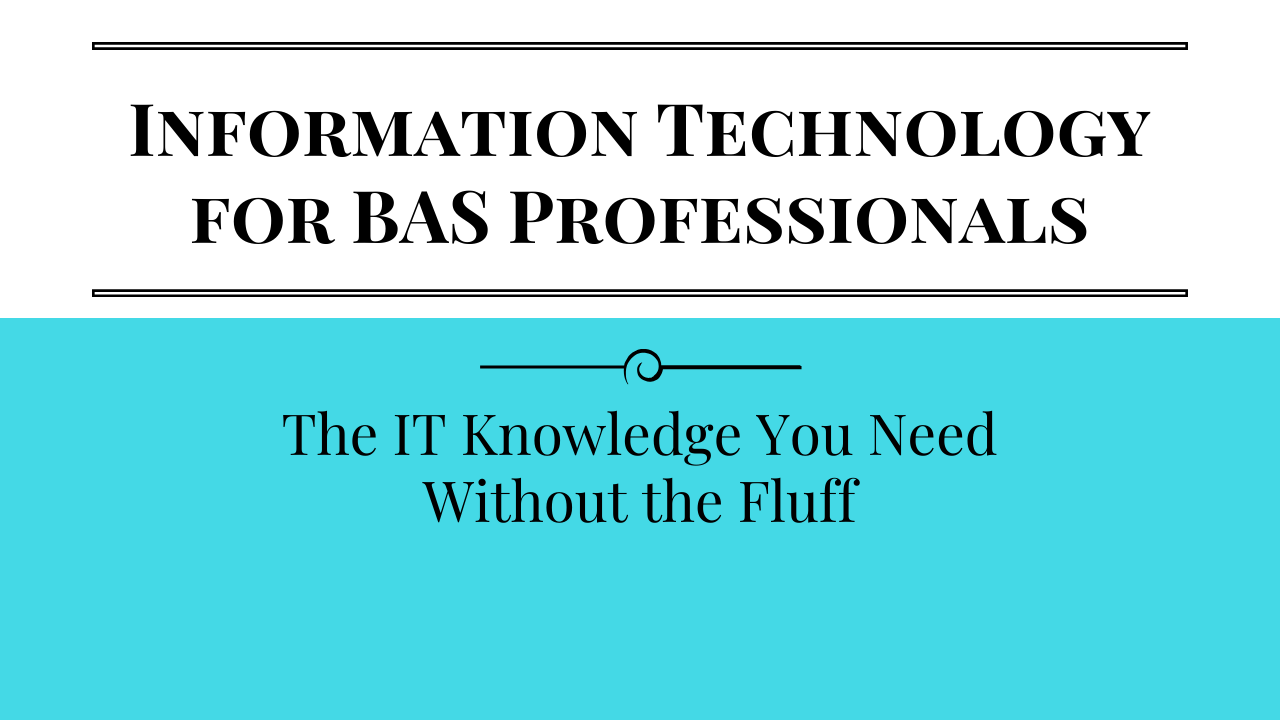Information Technology, IT, Technology!
Those words strike fear in the eyes of many BAS professionals. Now, before you get defensive, this has nothing to do with capabilities but rather it has to do with training. Up to this point no dedicated training program existed to provide those in the building automation space with the core IT skills they need in today's world.
That was, no program existed until now!
Enter, Information Technology for BAS Professionals my latest post, focused specifically on providing soup to nuts coverage of IT topics.
Until around 2012 I was an IT amateur. That all changed when I took a dedicated stance on learning all I could about IT and how I could use IT in my job to make me a more effective building automation professional. What I have gathered below is a partial sum of the knowledge I have acquired.
Look at this post as a reference when you run into IT related concepts that you do not understand you can refer back to this post. As time goes on and I get feedback from my readers I will add and adjust content to make this the best damn IT resource for Building Automation professionals.
So without Further Ado,
Information Technology for BAS Professionals
IT is simple, it only seems complex because there are so many different names for the same thing. When rubber meets the road all you really need is a few core concepts. Those concepts are:
- Network Fundamentals
- Remote Access
- SQL
- Sub-Netting
- Web Servers
Conveniently, I happen to have articles written around each of the topics!
But rather than just linking to these articles and calling it a day I am going to describe each category, tell you why the category matters and what you should be focusing on learning.
Network Fundamentals
Nothing gets transferred without a network right? And that is why you must know some basic things about networks.
Specifically, you will want to understand:
- What is a Network Interface Card?
- What is the difference between a static and dynamic IP address?
- What is a route? And what is a Router?
- What is an IP Address? What is a MAC address?
These concepts are invaluable and every BAS professional should understand them. Network Fundamentals become increasingly important when you consider that the majority of BAS manufacturers are switching their field controllers to speak IP.
Now that I have told you what you need to learn, let me provide you a link to my article Network Fundamentals.
In this article you will learn all of the core concepts surrounding networking.
Remote Access
Remote connectivity is probably one of the most misunderstood areas surrounding information technology. No single technology has the capability of so dramatically impacting your business like Remote Login technologies.
Why you ask?
Let's run through a scenario quickly.
Lighting strikes near your building and causes a power fluctuation. Now being a good building automation professional you've already set alarms to trigger and notify you via email when your system fails. However, now that the building system has failed and caused all the lights and HVAC failed on you have to physically roll a truck to reset the system.
Or do you?
With remote connectivity you can simply reset the system with the literal click of a button. If you researched your past service calls and summed up the costs involved in rolling trucks or calling service technicians you could easily be into the 5 figures.
Therefore, remote access is something I recommend be setup on all jobs.
But what kind of remote access?
- Can you simply setup a site to site VPN?
- How about a client based VPN?
- What about just configuring the server to be accessible with a public IP?
This and many more topics will be discussed in my article on VPN's.
SQL
Structured Query Language better known as SQL (pronounced Sequel). This is the language in which all of your trend, alarms, and other BAS data are stored. If you want to be able to produce your own reports or combine the data from multiple systems this is the language to know.
SQL consists of a series of commands called statements. The primary uses for SQL statements are:
- Create- Create Data Record
- Read- Read Data Records
- Update- Update Data Records
- Delete- Delete Data Records
In the case of Building Automation your primary focus will be on reading SQL data through SELECT and UNION statements.
Fortunately I have written two articles that focus on these exact statements. In my articles you will learn how to write SELECT statements and how to combine data from two or more databases using a UNION Statement.
With these two statements you can report on your data like never before.
To read about SELECT statements click here and to read about UNION statements click here.
Sub-Netting
Have you ever had to ask someone in you or your customers IT department for a set of IP Address for your BAS?
If so then this section talks directly to you!
Are you curious about the seemingly mystical IT voodoo magic that creates IP Addresses?
Well sub-netting is the how and it is a critical skill to understand in both system design and system troubleshooting. For example if I told you that you had a /24 IP address on a /23 network would you understand what I meant and the ramifications of that?
If you don't understand that you will after reading my article on sub-netting. The key concepts for you to grasp are:
- What is a subnet?
- What classes of address are there?
- How do I determine the available IP addresses on my network?
You can learn all of this and more here.
Web Servers
Did you know that your BAS is a web server?
Yes, your JACE, NAE, PXC they are all web servers.
So what is a web server? Do you know?
If you don't its critically important that you do. If you are getting errors when you try to access your graphics or if you are getting HTTP error codes they are most likely coming from an issue related to your web server.
In my post on web servers I teach you:
- How does a web server function?
- What purpose does a web server serve?
- How is a web server setup?
Those are core concepts that you must understand if you will be supporting or servicing a modern building automation system.
You can read about web servers here.
Conclusion
So, how do you feel?
Did this course provide you with a core set of skills to help you understand core IT concepts?
What else do you feel you need to know about?
Share your thoughts in the comments below!
And do me a favor, if you like the posts I am writing check the Yes, I want to be a subscriber box when you post a comment or simply use the form below to subscribe.






